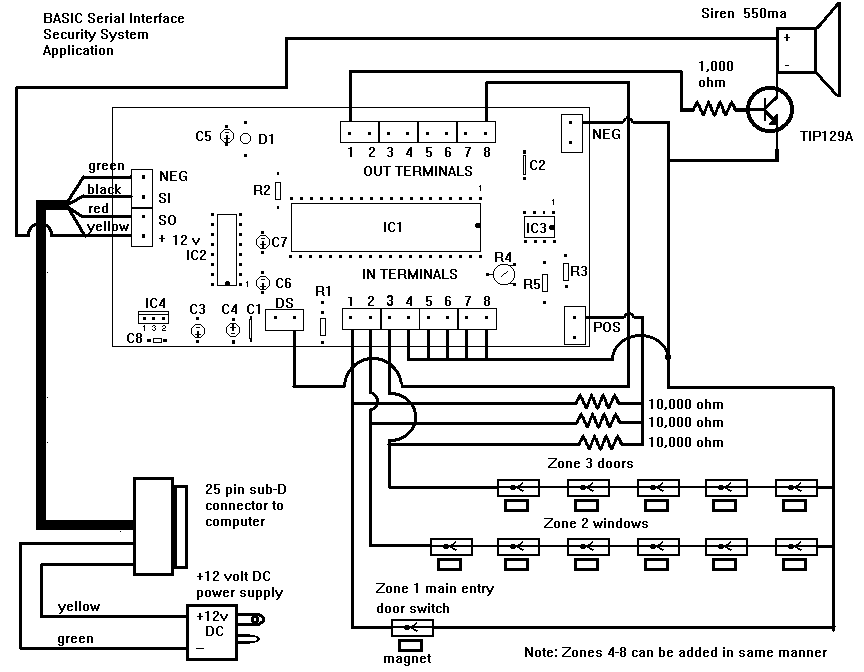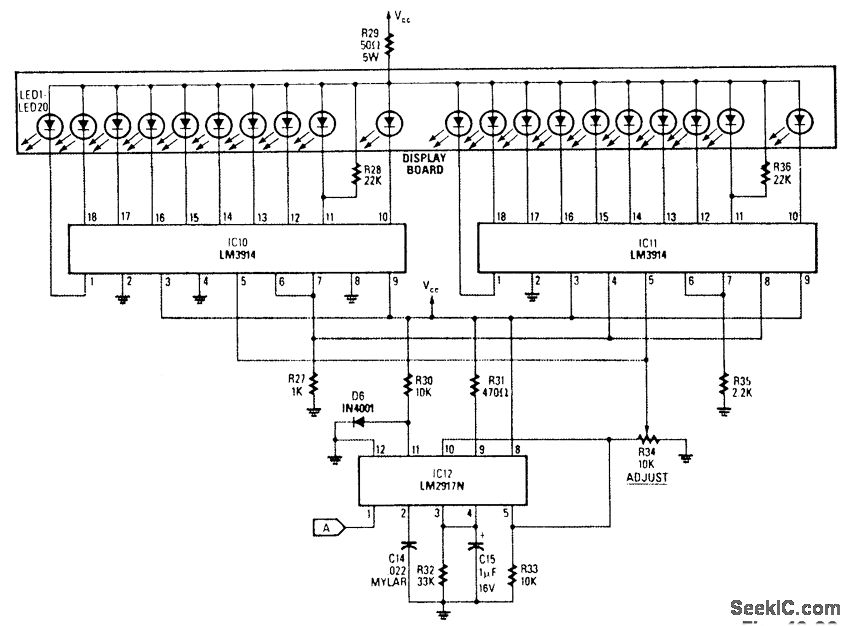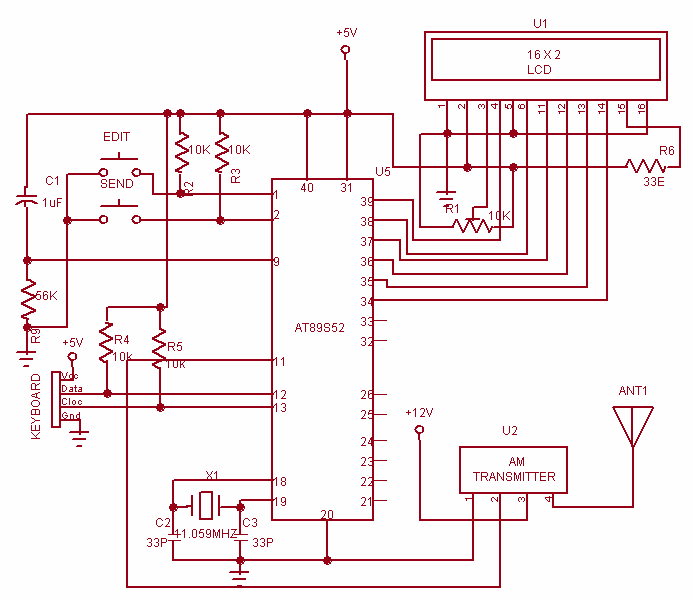
Home security system

The security system application and program offers a simple demonstration of the BASIC Serial Interface. By adding only a few door and window switches, a transistor, a siren, and a few lines of BASIC program the interface can become a multi-function security system. Please note, however, that it is a "barebones" program. It is left to the reader to fancy it up to their liking.
The described security system utilizes a BASIC Serial Interface to facilitate communication and control of various security components. The core of the system consists of door and window switches that serve as input devices to detect unauthorized access. When a switch is triggered, it sends a signal to a microcontroller, which processes the input.
The microcontroller is connected to a transistor, which acts as a switch to control the activation of a siren. The transistor is necessary to handle the higher current required by the siren, ensuring that the microcontroller operates safely within its specifications. The siren serves as an audible alarm to alert users of a security breach.
The schematic for this setup would typically include the following components:
1. **Microcontroller**: This component executes the BASIC program and processes inputs from the switches.
2. **Door and Window Switches**: These are normally open (NO) or normally closed (NC) switches placed at entry points. When a door or window is opened, the corresponding switch closes or opens, signaling the microcontroller.
3. **Transistor**: A suitable NPN or MOSFET transistor is used to drive the siren. The base of the transistor is connected to a digital output pin of the microcontroller, allowing it to turn the siren on or off.
4. **Siren**: The siren is connected to the collector of the transistor, and its power supply is connected to the emitter. When the transistor is activated, it completes the circuit for the siren, producing sound.
5. **Resistors and Diodes**: Resistors may be included for current limiting, especially at the base of the transistor. A flyback diode is recommended across the siren to protect the circuit from voltage spikes when the siren is turned off.
The BASIC program controls the logic of the system, monitoring the state of the switches and activating the siren when a breach is detected. While the program is described as "barebones," it provides a foundational structure that can be expanded with additional features, such as notification systems or integration with smart home technologies.
This security system serves as a basic yet effective prototype for understanding the principles of electronic security applications and can be further developed to meet specific user needs.The security system application and program offers a simple demonstration of the BASIC Serial Interface. By adding only a few door and window switches, a transistor, a siren, (see schematic) and a few lines of BASIC program (see program listing) the interface can become a multi-function security system.
Please note, however, that it is a "barebones" program. It is left to the reader to fancy it up to their liking. 🔗 External reference
The described security system utilizes a BASIC Serial Interface to facilitate communication and control of various security components. The core of the system consists of door and window switches that serve as input devices to detect unauthorized access. When a switch is triggered, it sends a signal to a microcontroller, which processes the input.
The microcontroller is connected to a transistor, which acts as a switch to control the activation of a siren. The transistor is necessary to handle the higher current required by the siren, ensuring that the microcontroller operates safely within its specifications. The siren serves as an audible alarm to alert users of a security breach.
The schematic for this setup would typically include the following components:
1. **Microcontroller**: This component executes the BASIC program and processes inputs from the switches.
2. **Door and Window Switches**: These are normally open (NO) or normally closed (NC) switches placed at entry points. When a door or window is opened, the corresponding switch closes or opens, signaling the microcontroller.
3. **Transistor**: A suitable NPN or MOSFET transistor is used to drive the siren. The base of the transistor is connected to a digital output pin of the microcontroller, allowing it to turn the siren on or off.
4. **Siren**: The siren is connected to the collector of the transistor, and its power supply is connected to the emitter. When the transistor is activated, it completes the circuit for the siren, producing sound.
5. **Resistors and Diodes**: Resistors may be included for current limiting, especially at the base of the transistor. A flyback diode is recommended across the siren to protect the circuit from voltage spikes when the siren is turned off.
The BASIC program controls the logic of the system, monitoring the state of the switches and activating the siren when a breach is detected. While the program is described as "barebones," it provides a foundational structure that can be expanded with additional features, such as notification systems or integration with smart home technologies.
This security system serves as a basic yet effective prototype for understanding the principles of electronic security applications and can be further developed to meet specific user needs.The security system application and program offers a simple demonstration of the BASIC Serial Interface. By adding only a few door and window switches, a transistor, a siren, (see schematic) and a few lines of BASIC program (see program listing) the interface can become a multi-function security system.
Please note, however, that it is a "barebones" program. It is left to the reader to fancy it up to their liking. 🔗 External reference





